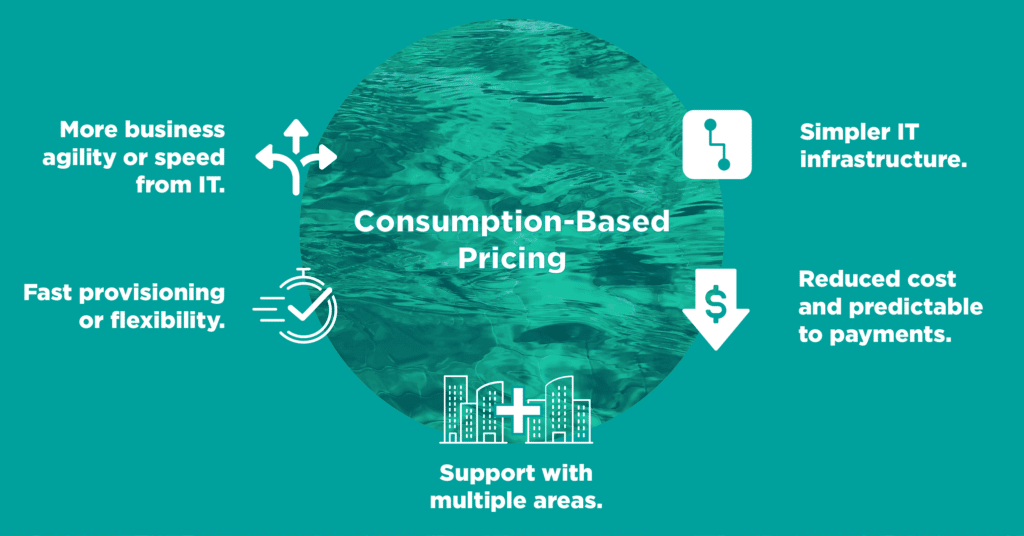Is Consumption-Based Pricing Right for Healthcare IT?
Creating a seamless digital experience is a matter of staying competitive for today’s healthcare systems. CIOs and their teams carried the weight of fast changes with the pandemic, such as supporting virtual desktop infrastructure for remote workforces and enabling telehealth programs for patients.
The pandemic set a new standard for digital healthcare. An organization’s ability to deliver on this standard can make all the difference when retaining patients and providers.
As hospitals and healthcare systems continue to face slim budgets, stretched resources, and increasing responsibilities, CIOs can alleviate their competing priorities with the help of consumption-based pricing models.

What Is Consumption-Based Pricing?

Consumption-based IT is a pay-per-use model that includes on-premise hardware, software, and support.
Any IT needs are delivered “as-a-Service” which means IT departments only pay for the technology and support they use. The key with any as-a-Service model is that support is delivered at an agreed-upon level outlined in a service level agreement, and the cost is fixed at a predictable monthly payment.
Healthcare IT Teams Have It Tough
Why look at healthcare IT specifically? The healthcare industry was hit hard by changes from the pandemic. Limited resources, increased responsibilities, and reduced budgets all stand in the way of CIOs’ top priority: patient engagement.
According to Stoltenberg Consulting’s healthcare IT outlook survey, 52% of CIOs listed patient engagement as their top priority for 2021. Patient engagement relates to attracting and retaining patients, and a hospital’s overall ability to stay competitive.
A Deeper Look at the Challenges Healthcare IT Teams Face
- Limited resources. For the second year in a row, the healthcare IT outlook survey showed retaining qualified IT resources ranked as the greatest operational burden for CIOs. Leaders need to carefully deploy resources in areas that matter for the business to stay competitive, such as optimizing digital experiences for both patients and providers.
- Increasing responsibilities. The pandemic forced digital transformation faster than many organizations had planned. This focus on digital experiences means IT resources are dedicated to initiatives such as telehealth programs, VDI, and managing helpdesk. This is in addition to their ongoing responsibilities of digital health records and scaling storage capacity.
- Reduced budgets. The majority of hospitals and health systems are keeping budgets the same or decreasing their budgets, according to Revcycle. With their focus on maintaining digital efforts and getting the most out of their current IT purchases, CIOs are balancing increasing demands with limited resources.
These competing priorities influence the rise of consumption-based IT models. Consumption-based pricing such as with HPE GreenLake creates cloud-like flexibility with on-premises control. Healthcare IT departments can choose the right mix and level of services for their business. This quickly alleviates the burden on resources with the flexibility to scale and no upfront cost barrier.
5 Ways Consumption-Based Pricing Optimizes Healthcare IT Environments

Today’s healthcare IT needs to act quickly, from telehealth programs that support remote care, to seamless digital experiences that retain patients. The bar for digital health is high—and consumption-based IT can help CIOs meet it. This growing IT model is right for IT teams that need…
- More business agility or speed from IT. According to the IDC Worldwide Cloud 2019 Predictions, a top reason for upgrading IT is to gain agility. The report showed 55% of respondents said business demands for more agility or speed from IT were a leading factor for upgrading. Consumption-based models bring both speed and flexibility to quickly benefit IT teams.
- Fast provisioning or flexibility. Increasing responsibilities means increasing demands on available technology. The ability to move quickly can make or break the competitiveness of a hospital. Consumption-based models enable cloud-like flexibility with fast provisioning when needed.
- Support with multiple areas. Consumption-based. Usage-based. Pay-as-you-go. As-a-Service. All of these IT models mean the end user selects the appropriate mix of technology that’s right for their needs. The solutions are managed by a technology service provider, such as Comport, in a way that’s exactly right for your IT team. You decide the appropriate level of service you’d like for managing your IT.
- Simpler IT infrastructure. As IT systems grow, they inevitably become more complex. The IDC report predicts that by 2023, more than 50% of enterprise IT operations spend will be consumption-based in part because of its ability to manage complexity. Consumption-based IT models simplify infrastructure by offering a more consistent and standardized availability of automated cloud resources. This means faster IT at a predictable cost.
- Reduced cost and predictable payments. The flexibility that consumption-based models provide mean CIOs can trim capacity and service levels when needed. This ability to strategically trim services can provide an IT cost savings of approximately 30% according to a report by McKinsey. In addition to the potential to reduce cost, consumption-based pricing models bring predictability to billing cycles with a pre-determined, agreed-upon cost.
Flexibility, agility, support, simplified IT, and predictable payments are the top reasons consumption-based pricing models are ideal for the healthcare industry. Solutions such as HPE GreenLake have changed the way IT teams approach technology. No longer does digital transformation mean putting up a large upfront cost or overhauling your entire infrastructure.
Consumption-based IT creates a manageable path forward with expert guidance from Comport every step of the way. Get a better understanding of your costs before investing by test driving HPE GreenLake today.
Bill Flatley, Field CTO for Healthcare
Bill is responsible for technical strategies and recommendations for Comport’s Healthcare clients. His extensive experience includes four healthcare systems in leadership roles supporting Clinical Applications, Digital Health, and Office of the CIO as the primary liaison between IT and the business.



























